Beautiful naturally toned coins sell up to 30 times price guide value. Ugly naturally toned coins sell for as little as half price guide value. Coins with artificial toning sometimes gain a premium, but not when they are recognized as artificial. Price guides are most accurate when a coin is untoned or has subtle natural toning.
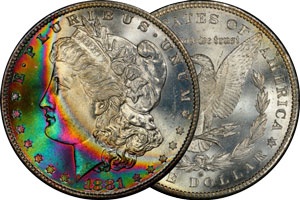
A beautifully naturally toned 1881-S Morgan Silver Dollar.
If you’re unsure about your coin’s toning, the Academy of Coins© has created an easy, quick, low-cost grading service alternative at PriceThatCoin.com.
PriceThatCoin.com is a much less expensive way to find out the value of your toned coin than traditional coin certification. And if you should certify your coin, we’ll tell you!
If you would prefer to learn to understand coin toning yourself, by all means, read on…
Telling Natural Versus Artificial Toning on Collectible Coins
“Toning” is a numismatic trade term for tarnish or oxidation. It’s completely natural for coins to tone over time, and they tone differently depending on how the storage environment exposes them to certain chemicals.
The eye appeal of a toned coin often has a significant impact on its value in the marketplace. The impact of a coin’s toning on sale prices is one substantial way that coin price guides fail.
It used to be that collectors greatly preferred bright, untoned coins. In the past two decades, there is an incredible bias toward eye appealing, incredibly colorful, incredibly lustrous, unbelievably natural toned coins.
Toned coins come a few ways: 1) attractive natural toning, 2) unattractive natural toning, and 3) artificial toning. There are also modestly naturally toned coins and artificially detoned coins (dipped). As coin doctors continue to improve their game, distinguishing between attractive natural and artificial continues to be more difficult, even for toned coin experts.
The TPGs are feeling the pressure, too. With beautiful coins demanding the highest prices, TPGs swing the fence between ensuring coins that go into their holders are completely natural and making sure the most beautiful (and valuable) coins go into their holders. There’s plenty of evidence that market pressures impact grading rooms around the country.
The difference in value between untoned lustrous coins and naturally toned lustrous coins can be anywhere between a small premium and seemingly outrageous multiples for coins of the same coin grade. Unattractive toning can impair values compared to untoned lustrous coins.
Naturally Toned Beautiful Coins
Naturally toned coins have been growing their own market for a couple of decades now. Advanced collectors grew tired of looking at the same bright shiny coins. When the Treasury released bags of mint state Morgans into the market, many naturally toned coins came to light. Some collectors loved the neon colors, while some hated them. Over time, deeply colored naturally toned coins have established a whole new niche in the market, demanding incredible prices. One naturally striped, multicolored neon-toned coin, common in every way but for its toning, sold for over 30 times its well-established price guide value. And the numbers get more ludicrous in proportion to the craziness of the colors.
Natural toning can be especially tricky on modern coins. Much original U.S. Mint packaging most often yields cloudy toning that from some angles is unattractive. From other (just right) angles, it may yield pretty colors. If the cloudy toning is completely symmetric, the coin can bring substantial multiples. If it’s the slightest bit off, it might bring an untoned price, or the value might well be impaired.
Buying and selling toned coins is quite tricky. Most toned coin sellers have felt out the market long enough to price their coins. But when they buy coins, they seldom pay the crazy money they ask for toned coins.
Selling toned coins, for the recognized toned coin experts, is like selling any other coin for any other type of coin specialist. But for the average collector looking to upgrade, selling toned coins can be extremely difficult. It’s best to have other toned enthusiasts ready to buy your old coins. If your coins are certified by a major TPG, they’re liquid on the market. eBay seems a favorable venue if your photography is good enough.
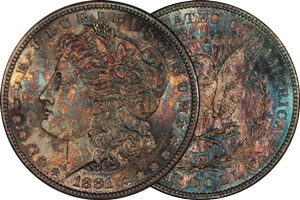
While what constitutes “ugly natural toning” is debatable, there’s no question the toning here will not enhance this common Morgan Dollar’s value.
Naturally Toned Ugly Coins
Although many ugly coins toned naturally, the market seems to consistently ding coins that are otherwise graded properly. Well-heeled collectors know how important eye appeal is, and they crave attractive coins for their collections. As a result, naturally toned unattractive coins don’t find the strongest buyers.
One option collectors have is to crack out and dip ugly toned coins. But they know when doing so they risk revealing flaws the toning covers. The coin may potentially drop in grade upon resubmission.
As with other problem coins, newer collectors often feel they’re getting a great deal for these coins when they look at price guide information without studying comparables. But the truth is, just as the coin wasn’t as salable when they bought it, the coin will likely remain difficult to sell.
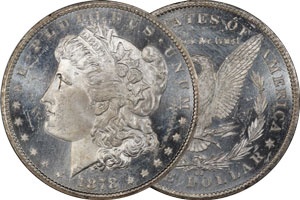
A bright Prooflike untoned Morgan Silver Dollar.
Untoned Coins
Untoned coins are usually a safe bet when considering investment potential. Past performance is no guarantee of future results, but… Although there are not typically wild upswings in the untoned coin market, there will likely be no sudden downturns.
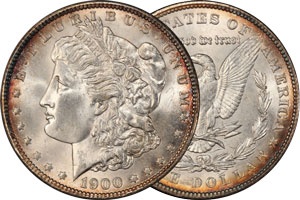
A naturally subtly toned Morgan Silver Dollar.
Some collectors prefer light natural toning to completely untoned, bright coins. A previous caretaker clearly dipped these completely untoned coins at some point. Especially in the case of vintage coins that are over 100 years old – metal is going to react to its environment somewhere along the way.
Coins with Attractive but Artificial Toning
Coin doctors still learning their craft often sell reasonably attractive coins to unsuspecting buyers. The trick for these dealers is to get their coins into the right TPG holder without a details grade, or to sell their wares raw to unsuspecting or uncaring buyers.
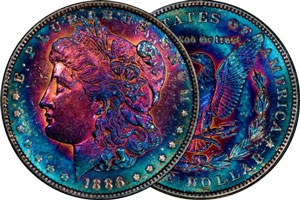
An obvious artificially toned Morgan Silver Dollar.
When toning doctors sell their coins with obvious artificial toning, they create a market and grow credibility with unwitting collectors. And some collectors know full well what they’re buying, but they want those really outrageous coins in their collection regardless. And there’s nothing wrong with that, so long as they are honest about what they have.
The problem arises when doctors and collectors sell coins with artificial toning as natural. The highly trained eye can already tell the difference between natural and artificial toning. At some point in the near future, technology will exist to easily differentiate natural from artificial toning. When that happens, a lot of seemingly reputable people will quickly lose credibility.
Coin doctors are now able to speed the toning process in a controlled environment. They’re able to produce what looks like decades of natural toning in a year or less. This time investment is worthwhile – coins can multiply in value many, many times if they appear natural and get full numeric (non-details) grade from PCGS or NGC.
Coins with artificial toning are tricky. If they get the blessing of a major TPG by accident, they will often get the same or slightly more than an untoned coin. If they look natural enough or manage to find buyers, they can bring multiples of up to 10x.
If you’re unsure how to differentiate artificially toned coins from naturally toned coins, you may wish to stay away from them. Or – as always – at least get a few opinions before making a major purchase that is not in line with price guide.
Knowing natural from artificial and natural attractive from natural unattractive toning takes finesse and experience, so don’t feel bad if you don’t get it right every time. The market is filled with inexperienced speculators who can’t quite yet tell the difference, too. That means results for certain coins aren’t consistent. And after all, beauty is in the eye of the beholder.
The market for toned coins can be whimsical, so if you want a purely safe bet, you may wish to stay away from toned coins. That said, the toned coin market is a bit more mature than it was even 10 years ago. One thing is certain though – to ensure your own coins’ market fluidity, always buy low and sell high. Remember that toned coin dealers seldom pay toned coin prices, even for rare, top graded coins.
If you choose to get into toned coins because you love them, be prepared to deal with the whims of the market when you’re ready to sell.
Continue learning about coins –
Previous: When Price Guides Fail – Problem Coins
